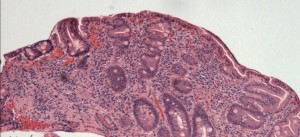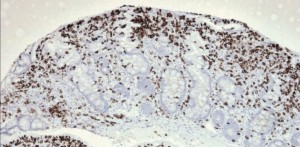Celiac disease occurs in adults and children at rates approaching 1% of the population, and is recognized around the world; not only throughout Europe and in countries populated by those of European ancestry (such as Australia, New Zealand, South Africa and South American countries) but also in the Middle East, Asia, Central America, Caribbean and North Africa. This high prevalence rate is based on serologic screening studies using sensitive and specific antibody tests. The bulk of those with celiac disease are undiagnosed, though the rate of diagnosis is increasing.

Poorly Responsive Celiac Disease
It has been estimated that up to 30% of people with celiac disease do not respond to the diet.

Causes of Poorly Responsive Celiac Disease
- Wrong diagnosis
- Gluten ingestion*
- Lactose intolerance*
- Pancreatic insufficiency*
- Microscopic colitis*
- Bacterial overgrowth
- Other food intolerances (fructose, lactose, soy)
- Collagenous sprue
- Ulcerative jejunitis
- Enteropathy-associated T-cell lymphoma
- Autoimmune enteropathy
- Refractory sprue (with or without clonal T-cell populations)
- *Quite common.
Evaluation
Correct Diagnosis. The most important step is to make sure that the patient actually has celiac disease. It is very difficult to respond to the diet if the diagnosis is incorrect. We will therefore review the original diagnostic intestinal biopsy. If a biopsy has not been performed before going on the diet, there will always be a question as to whether the patient has celiac disease. The assessment of the presence of the genetic markers for celiac disease (HLA DQ2/DQ8) is important at this stage. A gluten challenge may be indicated.
Ongoing gluten ingestion. However, the most common cause of failure to respond to the diet is ongoing gluten ingestion. This may well be intentional such as cheating on the diet on social occasions or the ingestion of communion wafers. Alternatively, it may well be due to lack of knowledge concerning the gluten content of processed foods. Over the counter health foods supplements, vitamins, nutritional aids may all well contain gluten. Rarely may lipstick or inhaled gluten in the workplace be the culprit. A dietitian knowledgeable about celiac disease and the intricacies of the gluten-free diet is the most important member of the team in the assessment of patients at this stage.
Microscopic Colitis. Patients with celiac disease have an increased incidence of microscopic colitis. This is an inflammatory condition of the colon diagnosed by biopsy of normal appearing colonic mucosa at colonoscopy. Colonscopy is therefore an integral step in the evaluation of the poorly responsive patient. It is important the doctor performing the procedure takes multiple biopsies from all areas of the colon to determine if colitis is present. Inflammatory bowel disease (Crohn’s Disease and Ulcerative Colitis) may be discovered at colonoscopy because people with celiac disease have an increased incidence of these conditions compared to the general population.
Treatments for microscopic colitis include non-specific therapies directed at diarrhea (lomotil, cholestyramine) bismuth containing drugs (Pepto Bismol), budesonide and immunosuppresants.
Bacterial Overgrowth. Bacterial overgrowth occurs commonly in celiac disease and may account for persistent symptoms of bloating, gas, abdominal pain and diarrhea. This is typically assessed by performing a breath test that detects abnormal production of hydrogen or methane in the breath after the ingestion of a sugar solution (lactulose or glucose). A course of an appropriate antibiotic may well eliminate the symptoms.
Pancreatic Insufficiency. In active celiac disease, the pancreas does not produce its usual complement of enzymes. This will result in malabsorption of fats and starches that may cause persistent symptoms. This can be assessed by the measurement of enzymes in the stool (pancreatic elastase I) or a fecal fat estimation. Gluten-free prescription strength pancreatic enzymes will result in resolution of symptoms.
Other Food Intolerances. In celiac disease there may well be a deficiency of mucosal enzymes that results in maldigestion and malabsorption of sugars. Examples include lactose intolerance and fructose intolerance. Both of these can be detected using breath tests and therapy is avoiding these sugars.
Low Fructose Diet
Other food intolerances are often reported by patients; however, these are difficult to assess. Soy intolerance is an example. We will perform food allergy testing (IgE). However, the yield of these tests in patients with celiac disease is not great and a positive test does not always reflect a true allergy or intolerance.
Refractory Celiac Disease (or Refractory Sprue)
Approximately 5% of patients may develop refractory celiac disease or refractory sprue. Refractory sprue is defined as a condition in which villous atrophy and symptoms persist despite a gluten free diet.
It may be primary, never responding to a gluten-free diet, or secondary, presenting as a relapse while on the diet. They may appear indistinguishable from untreated celiac disease and be very ill with severe malnutrition. Alarm symptoms may develop in a patient that has been stable on a gluten-free diet for a long period. These include abdominal pain, fever, diarrhea and recurrent malabsorption.
The recognition of specific lymphocyte markers on intraepithelial lymphocytes (IEL) has allowed the definition of normal or typical celiac disease from refractory celiac disease that may have a poor prognosis. Refractory celiac disease may be divided into two categories based on these lymphocyte markers: Type I has normal lymphocyte markers. These patients while sick usually respond to various medications that include steroids or immunosupressants. They do not go on to develop lymphoma. Type II has abnormal lymphycytes that fail to express normal lymphocyte markers and may well be clonally expanded. This is rare. When present, however, patients are usually very sick and have an overall poor prognosis with progression to lymphoma not uncommonly. Patients usually require treatment with steroids and immunosupressants. However, in view of the poor outlook, innovative therapies are being sought. These include biological agents and stem cell transplant.
Investigations of these patients with alarm symptoms on a strict gluten-free diet is frequently extensive and includes contrast radiology or CT enteroclysis, video capsule endoscopy, PET-scan and extended upper endoscopy, push or push and pull enteroscopy, and laparoscopy.
Treatment of refractory sprue includes nutritional support and repletion of vitamins and minerals together with a strict gluten free diet.
Patients may well require steroids that may be given in the form of prednisone in varying doses or budesonide that is an enteric coated form of poorly absorbed steroid that is active in the bowel wall. Critically ill pati ents may require immunosuppressive therapy in the form of azathioprine, or cyclosporine. Patients with type II refractory celiac disease often do not do well and innovative therapies are being sought. There are centers in Europe that are using stem cell transplants for patients with type II refractory celiac disease.